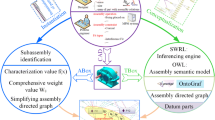Abstract
Disassembly, as one of the core steps in the end of life (EOL) activities, has been a popular topic both in industrial and academic areas. Unlike assembly, any practical disassembly process planning, which is very important for material recycling or component reuse, is still a topic of active research. One major obstacle in developing an optimal disassembly process planning system is the uncertain characteristics of the EOL products (uncertain information), such as the quality and quantity of the components and parts, which normally make a deterministic disassembly process planning impossible. How to represent and further use such uncertain information in reasoning about a realistic optimal disassembly process sequence are the most important research issues. This paper addresses these issues by developing a disassembly information framework which consists of both an ontology-based information model (domain semantics and rules) and a computational model (process planning generation methodology). The explicit domain concepts, relationships, or rules developed in the ontology-based information enhance the process planning generation methodology (computational model) and thus make the planning process efficient and more realistic. Examples are used in the end to illustrate the use of the proposed framework and methodology.
Similar content being viewed by others
References
Fenves SJ (2001) A core product model for representing design information, National Institute of Standards and Technology, NISTIR 6736. Gaithersburg, MD20899, USA
Fenves SJ, Foufou S, Bock C, Bouillon N, Sriram RD (2004) CPM2: a revised core product model for representing design information. National Institute of Standards and Technology, NISTIR 7185. Gaithersburg, MD20899, USA
Baysal MM, Roy U, Sudarsan R,Sriram RD, Lyons KW (2004) The open assembly model for exchange of assembly and tolerance information: overview and example. Proceedings of the DETC2004 ASME design engineering technical conferences. Salt Lake City, UT
Joung CB, Lee H, Ghodous P, Sriram RD, Feng SC, Kramer T (2011) Information model for disassembly for reuse, recycle, and remanufacturing. National Institute of Standards and Technology, NISTIR 7772. Gaithersburg, MD20899, USA
Zadeh LA (1975) The concept of a linguistic variable and its application to approximate reasoning I, II, II. Inf Sci 8:199–249–301–357, 9(1975), 43–80
Homem de Mello LS, Sanderson AC (1990) AND/OR graph representation of assembly plans. IEEE Trans Robot Autom 6(2):188–99
Tang Y, Zhou M (2000) Disassembly modeling, planning, and application: a review, proceedings of the 2000 IEEE, April
Fujiwara F, Suzuki T (1998) Integration of planning and scheduling for mechanical assembly based on timed petri net. Proceedings of Japan-US Symposium on Flexible Automation, Osaka
Moore KE, Gungor A, Gupta SM (1998) Petri net approach to disassembly process planning, computers. Ind Eng 35(1–2):165–8
Lambert AJD, Gupta SM (2005) Disassembly modeling for assembly, maintenance, reuse and recycling. CRC Press Boca Raton, Florida
Lambert AJD (1999) Linear programming in disassembly/clustering sequence generation. Comput Ind Eng 36(4):723–738
Lambert AJD (1997) Optimal disassembly of complex products. Int J Prod Res 35(9):2509–2523
Zussman E, Zhou MC (1999) A methodology for modeling and adaptive planning of disassembly processes. IEEE Trans Robot Autom 15:190–194
Martinez M, Pham VH, Favrel J (1997) Dynamic generation of disassembly sequences. In proceedings of 6th International Conference on Engineering technologies and factory automation, pp17-182
Geiger D, Zussman E, Lenz E (1996) Probabilistic reactive disassembly planning. CIRP Ann Manuf Technol 45:49–52
Guangdong T, MengChu Z (2012) Probability evaluation models of product cost subject to random removal time and different removal labor cost. IEEE Trans Autom Sci Eng 9:(2) April
Bobillo F, Straccia U (2011) Fuzzy ontology representation using OWL 2. In Int J Approx Reason
Zhu B, Roy U (2013) Disassembly information model incorporating dynamic capabilities for disassembly sequence generation. Robot Comput Integr Manuf. doi:10.1016/j.rcim.2013.03.003i
Gruber TR (1993) A translation approach to portable ontology specification. Knowl Acquis 5(2):199–220
Zhu B, Roy U (2013) Uncertain information representation and its usage in disassembly modeling. ASME 2013 International Design Engineering Technical Conferences (IDETC) and Comput Inform Eng Conf, Portland, US
Author information
Authors and Affiliations
Corresponding author
Rights and permissions
About this article
Cite this article
Zhu, B., Roy, U. Ontology-based disassembly information system for enhancing disassembly planning and design. Int J Adv Manuf Technol 78, 1595–1608 (2015). https://doi.org/10.1007/s00170-014-6704-8
Received:
Accepted:
Published:
Issue Date:
DOI: https://doi.org/10.1007/s00170-014-6704-8




